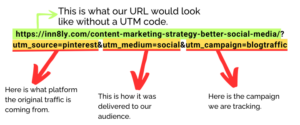Your cart is currently empty!

UTM Tracking – Data-Driven Marketing
Reading Time: 7 minutesAuthor:
Are you struggling to understand what parts of your marketing are working and what’s not?
Worried that you’re wasting time, energy, and resources on marketing efforts that just aren’t hitting the mark?
I get it. As a small business owner, I needed to know what channels were performing the best with my marketing efforts. With a limited budget and time, I needed to know where I should allocate my time and resources.
This is when I did some digging and learned about UTM Codes. These are essentially customized URLs you create to track the traffic with your marketing tactics.
So, what do UTM codes have to do with saving me time and money? And what do they have to do with marketing?
In this blog, I am going to teach you about UTM Codes and UTM Tracking Benefits. We are going to talk about what they are, why you should be using them in your marketing efforts, how you create them (and don’t worry, you’re not coding anything), where you can use them, and how you analyze the data from them to make educated marketing decisions. We will also discuss some best practices when creating and utilizing UTM codes and some tips on how to keep your codes organized.
Are you ready to dive in? Let’s go!
Table of Contents
Understanding UTM Tracking Codes
What are UTM Codes?
UTM codes are used to track specific traffic to a website or particular page. The codes are added to a website URL and provide additional information like the source and the medium. Later in the post, we will discuss the different parameters and how you can manage and customize them.
What does UTM Stand For?
UTM stands for Urchin Tracking Modules, which originated from Urchin Software before Google acquired it.
What does URL Stand For?
Let’s talk about another acronym that is familiar, but you may not know what it stands for. URL, it stands for Uniform Resource Locator, is specific to each page and acts as an address on the web.
Boost Your Marketing Precision
Harness UTM Codes to Track Campaign Effectiveness and Optimize Strategy

UTM Codes are used to precisely track specific elements in your marketing strategies. In a tool like Google Analytics 4, traffic is grouped into not very useful buckets by default. With UTM codes, the traffic is separated into discrete buckets and you can see what’s working and what’s not working. This lets you do more of what is working and scale back the less effective tactics. You can water the flowers and prune the weeds.
Next, let’s talk about creating a UTM code to start measuring those captivating marketing campaigns.
UTM Code Creation for Enhanced Campaign Tracking and Optimization
What Are the UTM Tracking Fields?
A UTM code has five parameters you can customize:
- Source
- Medium
- Campaign
- Term
- Content
Three of the five parameters, source, medium, and campaign, are required when creating your code. You can manage with these three, and you still will be better off. However, term and content are not required, but we will still review what they are and how you can use them because they can be useful.
Source
Your source identifies where the traffic originated from. It could be a PPC ad, a newsletter, or a social media platform, such as linkedin, mailchimp, or pinterest.
Notice that all of the examples I shared are in lowercase. This is for a reason that we’ wi’ll discuss when I share my best practices below.
Medium
The medium is how it was delivered to your audience. Was it in an email, a social media post, or an ad? You could use entries like email, social, or banner for this field.
Campaign
Campaign clarifies the specific marketing campaign that directs the traffic. This could be a promotion you are running, a goal you have set for your business or a specific product. Examples for this field are spring_sale, blogtraffic and inn8lylt.
Term
Term is not a required field when creating your UTM code, but it can still be helpful when optimizing your marketing efforts. Term is useful for paid search to identify keywords or keyword groups for the ad. These would be based on your keyword research for that specific campaign. To learn more about keyword research, check out our post, “Unlocking the Secrets of Keyword Research.”
Content
Content is also an optional field. It can be beneficial for A/B testing and content-targeted ads to differentiate links that point to the same URL.
How to create a UTM Code?
We use Google’s Campaign URL Builder to create our UTM codes. This platform allows you to shorten your links if necessary.

To start, you need your URL, know where you are going to share this new code your creating, know how your sharing it and why. These are all parameters that we talked about above. Once you have these, you can start creating your code.
Here are a few keys tips to follow when creating and organizing your tips. These tips will give you consistent, clear data to avoid confusion.
Tip # 1 Keep It Simple
Use clear and concise tags that are easy to understand at a glance.
Tip # 2 Be Consistent
Stick to a consistent naming convention across all your campaigns to avoid confusion and ensure data consistency.
Tip # 3 Use Lowercase Letters
To avoid discrepancies caused by case sensitivity in analytics platforms, always use lowercase letters in your UTM parameters.
Tip # 4 Limit Special Characters
Avoid using spaces and special characters; use underscores (_) or dashes (-) instead of space.
Tip # 5 Apply UTM Codes Across All Digital Marketing Channels
Use UTM codes for all your ads, social media posts, emails, and other marketing efforts to ensure consistency.
Tip # 6 Adjust Strategies Based on Data
Use the data from UTM codes to refine your marketing strategies and budget allocation.
These six tips will get you started. We have a full checklist of best practices and tips on keeping your codes organized. If you would like this checklist, use the button below, and we will send it right to your inbox.

Using UTM Codes to Enhance Your Understanding of Traffic
In order to make it clear on how to use a UTM code to understand your traffic, let’s look at a UTM code I created for a blog post we are sharing on Pinterest. The information I needed to create this code was the original URL, the source, which is pinterest, the medium which is social (like social media), and the campaign which is blogtraffic.
This link tells me how much traffic is coming from Pinterest to read this particular blog post. I can use this code alongside another code for a different platform to separate the traffic and determine which platform my audience favors when reading my blog.

UTM Codes In Action- How to Use Them in Your Current Marketing Strategies
UTM codes can be used anywhere you would use a link to your website. Two examples that I bet you are using right now are your social media efforts and your email marketing.
Using UTM codes in your social media.
If you share a new product on your social media and want to see if Instagram or Facebook get more attention, you can use UTM codes to separate the traffic in GA4. You would create a code for Facebook and a code for Instagram, then observe the results. Further down, we will talk about how to measure the data you get from your codes.
The codes that you created can be added to the link you use to direct traffic back to your website. For example, your links in your bios and in links in your stories. These codes would all use the same campaign ID, but the source and medium would differ based on your channels and tactics.
Using UTM Codes in your Email Marketing.
When creating email marketing for your audience, you often include links to products you are promoting or a new blog post on your site. Guess what? You can add UTM codes to these links.
Your UTM code that you create for the email can be specific to your email marketing efforts. This can show you if people are reading your blog or checking out your new products based on the suggestions in your email. Now, you can get click data from your email service provider, but with UTM tracking codes, you can follow visitor behavior as they move through your site using GA4.
How to Use Google Analytics 4 with UTM Codes to Optimize Your Marketing Strategy
We use Google Analytics 4 to analyze the data coming from our UTM codes. This is easy and free. Which metrics you analyze depends on your overall objectives.
If your objective is to determine which platforms are driving the most traffic and engaging users effectively, then you need to pay attention to number of visitors, bounce rate, time on page, and conversion rate per source.

If your objective is to compare the effectiveness of different marketing media then you need to analyze engagement metrics such as session duration, pages per session and conversion rate per medium.
If your objective is to track the performance of individual marketing campaigns or to understand which promotions are resonating with your audience then you need to check out different metrics than the ones mentioned above. You want to review campaign-specific conversion rates, sales data and overall ROI.
Whether your objective is increasing traffic to your website or determining which platform is performing the best for your campaigns, UTM codes give you the information you need to assess your progress.
Based on this data, you can identify the channels, tactics, and campaigns that are working the best and which are not working.
UTM Tracking Benefits: Precise Marketing & Results- Final Thoughts
In this post we talked about what UTM codes are, how to create them, and why you should use them in your marketing strategy, and where you can use them.
We also went over a few best practice tips to keep you consistent and organized.
I hope that with this information you are now able to analyze your marketing campaigns to make data-driven marketing decisions for your business.
Related Posts
-
UTM Tracking – Data Driven Marketing
Maximize marketing ROI with performance tracking.
-
Use Split Testing to Elevate Your Marketing
Unleash the power of split testing and revolutionize your marketing strategies.
-
Statistical Significance
Measure A/B tests for statistical significance – improve your marketing.
Author: Bonnie Conrad
Bonnie, a military spouse, has worked in both the public and private sectors throughout her career. Leaving the corporate world behind, she started her own small business and struggled with digital marketing. Determined to overcome this, she immersed herself in digital marketing. The dedication allowed her to pinpoint key factors distinguishing superficial content from valuable social media strategies that truly benefit customers and businesses. Bonnie’s clients appreciate her honest, no-frills feedback.
Use this link to book a meeting time with Bonnie.

